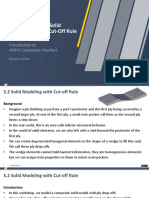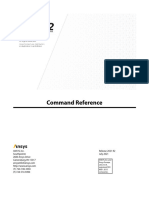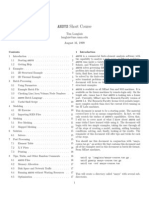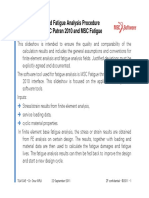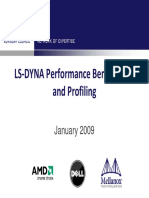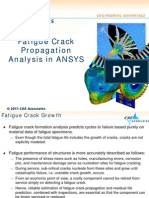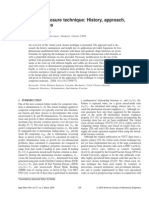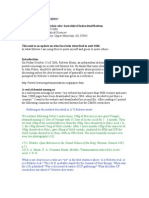Virtual Crack Closure Technique (VCCT) in Ansys: © 2011 CAE Associates
Virtual Crack Closure Technique (VCCT) in Ansys: © 2011 CAE Associates
Uploaded by
Raj Kumar RCopyright:
Available Formats
Virtual Crack Closure Technique (VCCT) in Ansys: © 2011 CAE Associates
Virtual Crack Closure Technique (VCCT) in Ansys: © 2011 CAE Associates
Uploaded by
Raj Kumar ROriginal Description:
Original Title
Copyright
Available Formats
Share this document
Did you find this document useful?
Is this content inappropriate?
Copyright:
Available Formats
Virtual Crack Closure Technique (VCCT) in Ansys: © 2011 CAE Associates
Virtual Crack Closure Technique (VCCT) in Ansys: © 2011 CAE Associates
Uploaded by
Raj Kumar RCopyright:
Available Formats
Virtual Crack
Closure Technique
(VCCT) in ANSYS
2011 CAE Associates
Delamination Techniques
Two techniques exist in ANSYS to simulate the behavior of delamination
of layers in a composite material:
Virtual crack closure technique (VCCT).
Cohesive zone model (CZM).
Both techniques use special elements (interface or contact) along a predefined interface to model the delamination of cracks.
The procedure selected by the analyst is based on considerations of the
strengths and weaknesses of both methods.
www.caeai.com
Delamination Techniques
CZM relates interfacial tractions to displacement discontinuities.
Strengths:
Predicts initiation and growth of delamination without a priori assumptions about the
crack.
Applicable to complex structures subjected to complex loading states.
Weaknesses:
Characterization data can be difficult to obtain.
Accurate assessments are strongly tied to element size.
VCCT calculates energy-release rate, with the assumption that the energy
needed to separate a surface is the same as the energy needed to close
the same surface.
Strengths:
Mature fracture mechanics-based technique with large body of work.
The growth criteria is the energy release rate, G.
Weaknesses:
Assumptions about cracks must be made (number, location, size).
Can be difficult to incorporate for complex structures and loading.
www.caeai.com
VCCT: Energy Release Rate Calculation
The mode I and II energy release rate expressions used in VCCT,
assuming a 2D crack geometry and lower order elements:
Approach can be extended to 3D and higher order elements.
1
GI =
R y v
2a
1
GII =
Rx u
2a
Crack extension
u and v:
Relative
displacements
of crack face
Rx and Ry :
Reaction forces at
crack tip node
Crack tip node
www.caeai.com
VCCT: Energy Release Rate Calculation
The ANSYS procedure for calculating the VCCT energy release rate uses
the CINT command.
CINT command used to define:
Similar to J-Integral calculation in ANSYS.
Crack location: crack tip (2D) or crack front (3D) node component.
Crack extension direction: by identifying node on the open side of crack or a
local coordinate system axis.
Option to indicate that the crack runs along a symmetry plane.
This procedure is used to calculate the energy release rate for a given
crack of a specific length and position.
www.caeai.com
VCCT Example
Returning to demonstration problem of compact specimen:
Use ANSYS VCCT method and compare with previous results.
www.caeai.com
VCCT Example
Demonstration problem: ANSYS VCCT method.
CINT commands used to define crack tip node and crack path.
Same model as in J-Integral but with lower-order elements.
Energy release rates determined by ANSYS:
GI = 0.00160 lb/in
Using previous expression for linear elastic isotropic plane strain
assumption, calculate KI:
K I 1 2
J=
=G
E
2
www.caeai.com
KI = 229.4 psi-in1/2
KI Comparison
Summary of results:
Method
KI
Empirical
227.7
Special Crack Tip Elements
225.6
J-Integral
225.3
VCCT
229.4
www.caeai.com
VCCT Crack Growth (Coming in V14)
An automated crack growth simulation procedure, using the VCCT energy
release rate calculation, is available in ANSYS.
Assumptions:
Available with lower order current technology elements PLANE182 and
SOLID185.
Crack growth along predefined path new command CGROW.
The path is defined with interface elements INTER202 and INTER205.
Static analysis.
Linear elastic material.
Isotropic, orthotropic or anisotropic materials can be used.
Several fracture criteria are available including a user-defined option.
Multiple cracks are allowed.
www.caeai.com
VCCT Crack Growth
Example case run in version 13 (undocumented).
Double cantilever beam, separating along interface.
INTER202 elements define interface (CZMESH command).
Linear fracture criterion defined based on critical energy release rates.
Undocumented TB,CGCR option.
Crack growth automated with undocumented CGROW command.
Defines crack path, fracture criterion, time steps.
Interface
www.caeai.com
10
VCCT Crack Growth
There are 7 fracture criteria that can be defined using the TB,CGCR
material definition option.
All criteria are based on some definition of the critical energy release rate Gc.
For example, the linear fracture criterion:
GT
f = C
GT
GT = GI + GII + GIII
GTC = critical energy release rate.
Fracture occurs when:
www.caeai.com
f 1
11
VCCT Crack Growth
Animation of displacement.
www.caeai.com
12
VCCT Crack Growth
Force vs. deflection of delamination.
www.caeai.com
13
You might also like
- A User-Material Subroutine Incorporating Single Crystal Plasticity in The Abaqus Finite Element ProgramDocument47 pagesA User-Material Subroutine Incorporating Single Crystal Plasticity in The Abaqus Finite Element ProgramangrycabbageNo ratings yet
- Ansys - VM ListDocument6 pagesAnsys - VM ListRUDHRA DHANASEKARNo ratings yet
- Get Cracking With ANSYS Workbench 19.2 - Digital Engineering 24 - 7Document15 pagesGet Cracking With ANSYS Workbench 19.2 - Digital Engineering 24 - 7Sujay BhattacharyaNo ratings yet
- AdvFem Meshfree 2016classDocument282 pagesAdvFem Meshfree 2016classzack100% (1)
- HW11.0.101-HWDesktop Release NotesDocument38 pagesHW11.0.101-HWDesktop Release NotesAltairKoreaNo ratings yet
- A-ANSYS 15.0 Mechanical APDL Element ReferenceDocument1,448 pagesA-ANSYS 15.0 Mechanical APDL Element ReferenceBao LamNo ratings yet
- ANSYS Workbench Verification ManualDocument236 pagesANSYS Workbench Verification ManualTrịnh HuyNo ratings yet
- ANSYS Offshore Solutions What You Will Learn AboutDocument3 pagesANSYS Offshore Solutions What You Will Learn AboutkysucoNo ratings yet
- 2022 Installation Guide Ansys 2022R1-52409198Document5 pages2022 Installation Guide Ansys 2022R1-52409198Wilmer E Cumbicus JiménezNo ratings yet
- Progressive Failure Analysis of Composite Materials Using The PucDocument87 pagesProgressive Failure Analysis of Composite Materials Using The PucMansingh YadavNo ratings yet
- Nonlinear Nite Element Modeling of RC Beams Strengthened With NSM FRP RodsDocument11 pagesNonlinear Nite Element Modeling of RC Beams Strengthened With NSM FRP RodsRosNo ratings yet
- ACP Intro 2020R1 WS05.2 Solid Model Cutoff RuleDocument18 pagesACP Intro 2020R1 WS05.2 Solid Model Cutoff RuleV CafNo ratings yet
- PADT Webinar Series: An Example of Moving Mesh Modeling of A ValveDocument20 pagesPADT Webinar Series: An Example of Moving Mesh Modeling of A ValvevahidssNo ratings yet
- Buckling SummaryDocument14 pagesBuckling Summaryfahrgeruste3961No ratings yet
- Ansa Model Checks For Ls-DynaDocument5 pagesAnsa Model Checks For Ls-DynaShailesh SainiNo ratings yet
- Large Deformation BeamDocument10 pagesLarge Deformation BeamAdimasu AyeleNo ratings yet
- Non-Linear Load Balancing: Workshop 9Document18 pagesNon-Linear Load Balancing: Workshop 9sujaydsouza1987No ratings yet
- NafemsDocument29 pagesNafemsRahul JainNo ratings yet
- ANSYS Motion 2019 R3 EHD Bearing TutorialDocument13 pagesANSYS Motion 2019 R3 EHD Bearing TutorialbadaboyNo ratings yet
- 10 List Group PAT301Document40 pages10 List Group PAT301Dadir AliNo ratings yet
- Boston Ugm Fracture Mechanics in Ansys Mechanical 145 PDFDocument23 pagesBoston Ugm Fracture Mechanics in Ansys Mechanical 145 PDFSGASDGASDNo ratings yet
- Reference - ANSYS MAPDL Command ReferenceDocument2,128 pagesReference - ANSYS MAPDL Command ReferenceTrường HàNo ratings yet
- Documentation AbaqDocument86 pagesDocumentation AbaqKristi GonzalesNo ratings yet
- AnsysDocument18 pagesAnsysmechanical engineering100% (12)
- Fatigue Analysis MSC PatranDocument21 pagesFatigue Analysis MSC PatranAydin100% (1)
- ANSYS Multibody AnalysisDocument74 pagesANSYS Multibody AnalysisPaul NewmanNo ratings yet
- Finite Elements of 2 and 3 DimensionsDocument125 pagesFinite Elements of 2 and 3 DimensionsManish ShrikhandeNo ratings yet
- LsoptDocument407 pagesLsoptkwalls71No ratings yet
- Course Project Report On LS-DYNADocument26 pagesCourse Project Report On LS-DYNAShikhar KothariNo ratings yet
- Buckling, Postbuckling, and Collapse Analysis With Abaqus: About This CourseDocument11 pagesBuckling, Postbuckling, and Collapse Analysis With Abaqus: About This CourseEvgeny ShavelzonNo ratings yet
- NonLinear MaterialsDocument12 pagesNonLinear MaterialsNafees ImitazNo ratings yet
- Submodeling Using ANSYS WorkbenchDocument22 pagesSubmodeling Using ANSYS WorkbenchArkana AllstuffNo ratings yet
- ANSYS Running ANSYS Fluent Using A Load Manager 18.2Document54 pagesANSYS Running ANSYS Fluent Using A Load Manager 18.2Panda HeroNo ratings yet
- ANSYS Finite Element Analysis Coordinate SystemDocument12 pagesANSYS Finite Element Analysis Coordinate SystemnahoNo ratings yet
- MSC Training Catalogue 2014: Hängpilsgatan 6, SE-426 77 Västra Frölunda, Sweden Tel: +46 (0) 31 7485990Document44 pagesMSC Training Catalogue 2014: Hängpilsgatan 6, SE-426 77 Västra Frölunda, Sweden Tel: +46 (0) 31 7485990Vikas HNo ratings yet
- 9 - MSC-Trainings-2019Document70 pages9 - MSC-Trainings-2019AhmedBrahamNo ratings yet
- Progressive Damage Simulation Methods For Laminated Composites Using AbaqusDocument65 pagesProgressive Damage Simulation Methods For Laminated Composites Using AbaqusKetan KhamgaonkarNo ratings yet
- Fracture in Fiber Reinforced Composite Material:Mathematical Models and Experimental MethodsDocument54 pagesFracture in Fiber Reinforced Composite Material:Mathematical Models and Experimental MethodsSubayyal IlyasNo ratings yet
- Finite Element Simulation of A Detachable Wing Box in Composite Materials For Small AircraftDocument16 pagesFinite Element Simulation of A Detachable Wing Box in Composite Materials For Small AircraftIsaías Chamorro CruzNo ratings yet
- Nastran 2012 Superelements UgDocument974 pagesNastran 2012 Superelements Ugds_srinivasNo ratings yet
- LS-DYNA AnalysisDocument29 pagesLS-DYNA AnalysisJohn TerryNo ratings yet
- XFEM MethodDocument24 pagesXFEM MethodjangdiniNo ratings yet
- Radioss Theory Manual 12.0 Version Nov 2Document52 pagesRadioss Theory Manual 12.0 Version Nov 2M Muslem AnsariNo ratings yet
- ANSYS Mechanical APDL Command Reference: Release 16.2Document36 pagesANSYS Mechanical APDL Command Reference: Release 16.2ashishNo ratings yet
- Large Storage Tanks Foundation Settlement Structural Mechanics Characteristics AnalysisDocument7 pagesLarge Storage Tanks Foundation Settlement Structural Mechanics Characteristics Analysisvirat_daveNo ratings yet
- Damage Mechanics in Metal Forming: Advanced Modeling and Numerical SimulationFrom EverandDamage Mechanics in Metal Forming: Advanced Modeling and Numerical SimulationRating: 4 out of 5 stars4/5 (1)
- VCCT in AnsysDocument13 pagesVCCT in AnsysbnidhalNo ratings yet
- Crack Propagation in AnsysDocument24 pagesCrack Propagation in Ansysagrbovic100% (2)
- Automated Crack Extension Fracture SeminarDocument23 pagesAutomated Crack Extension Fracture SeminarSPNo ratings yet
- Crack Tracking ExplanationDocument14 pagesCrack Tracking ExplanationPablo CollNo ratings yet
- VCCT FEM Kreuger PDFDocument35 pagesVCCT FEM Kreuger PDFrrmerlin_2No ratings yet
- VCCTDocument35 pagesVCCTAshutosh SinglaNo ratings yet
- Fatigue Crackprop in AnsysDocument25 pagesFatigue Crackprop in Ansyssugunadevi.drNo ratings yet
- ExtractDocument78 pagesExtractashutosh_nist10No ratings yet
- Improved Staggered Algorithm For Phase-Field Brittle Fracture With The Local Arc-Length MethodDocument26 pagesImproved Staggered Algorithm For Phase-Field Brittle Fracture With The Local Arc-Length MethodhungNo ratings yet
- CAE Fatigue and Fracture Seminar - CZM For WebDocument21 pagesCAE Fatigue and Fracture Seminar - CZM For WebdamnkaushikNo ratings yet
- Voltage Stability Based Placement of Distributed Generation Against Extreme EventsDocument7 pagesVoltage Stability Based Placement of Distributed Generation Against Extreme EventsM8ow6fNo ratings yet
- Buckling and Fracture Analysis of Composite Skin/Stringer Panel Using VCCTDocument5 pagesBuckling and Fracture Analysis of Composite Skin/Stringer Panel Using VCCTsüleyman tazebayNo ratings yet
- K-Node Set Reliability Optimization of A Distributed Computing System Using Particle Swarm AlgorithmDocument10 pagesK-Node Set Reliability Optimization of A Distributed Computing System Using Particle Swarm AlgorithmOyeniyi Samuel KehindeNo ratings yet
- Advanced Opensees Algorithms, Volume 1: Probability Analysis Of High Pier Cable-Stayed Bridge Under Multiple-Support Excitations, And LiquefactionFrom EverandAdvanced Opensees Algorithms, Volume 1: Probability Analysis Of High Pier Cable-Stayed Bridge Under Multiple-Support Excitations, And LiquefactionNo ratings yet
- CTM Example - Modeling Pitch Controller Airplane PDFDocument5 pagesCTM Example - Modeling Pitch Controller Airplane PDFErnesto D. AguirreNo ratings yet
- Specific Heat Capacity and Latent Heat: AS Level Physics Notes OnDocument44 pagesSpecific Heat Capacity and Latent Heat: AS Level Physics Notes OnChrise RajNo ratings yet
- Material Data Sheet: Eos Maragingsteel Ms1Document5 pagesMaterial Data Sheet: Eos Maragingsteel Ms1Raj RajeshNo ratings yet
- The Inclined Towers of The Ebro and Lérez BridgesDocument3 pagesThe Inclined Towers of The Ebro and Lérez BridgesarazNo ratings yet
- Zero Extension Line TheoryDocument7 pagesZero Extension Line TheoryDavid Sta Rosa100% (1)
- 60Hz Notch Filter Analysis BE309F98M1R01Document15 pages60Hz Notch Filter Analysis BE309F98M1R0103458337271No ratings yet
- State SpaceDocument4 pagesState SpaceHai NguyenNo ratings yet
- Contextualized Modules in ScienceDocument37 pagesContextualized Modules in ScienceMarie RamosNo ratings yet
- Packed Towers - Class Notes 1Document9 pagesPacked Towers - Class Notes 1Farouk BassaNo ratings yet
- Sample Problem 1.1: 6 In. 1.75 In. 1.25 inDocument1 pageSample Problem 1.1: 6 In. 1.75 In. 1.25 inAnonymous g3Mz9CygCRNo ratings yet
- Agfa Formulas For Photos PDFDocument32 pagesAgfa Formulas For Photos PDFRaimundo Civera Redondo100% (1)
- Aerodynamic Properties ofDocument5 pagesAerodynamic Properties ofcomsy4everNo ratings yet
- Seperation Model EquationDocument130 pagesSeperation Model EquationHans Wurst100% (1)
- Analysis and Design of Chaos in Switched ReluctanceDocument20 pagesAnalysis and Design of Chaos in Switched ReluctanceRaaji NattuNo ratings yet
- Materials and Design: Hasan GedikliDocument9 pagesMaterials and Design: Hasan GediklidavidNo ratings yet
- Circular Water Tank With Domcal Top and BaseDocument20 pagesCircular Water Tank With Domcal Top and BaseSourav Chandra83% (6)
- Lab 3 Standard Protein Assay LabDocument5 pagesLab 3 Standard Protein Assay LabMark WayneNo ratings yet
- Alchemy Vs Cold FusionDocument52 pagesAlchemy Vs Cold FusionG Michael HobbsNo ratings yet
- Math1151 Matlab Lab Test PracticeDocument5 pagesMath1151 Matlab Lab Test PracticekelvinNo ratings yet
- Phy 204 HW5Document5 pagesPhy 204 HW5reshmakshivanandNo ratings yet
- Question Bank: Subject: EEM Class 6 Sem ElectricalDocument4 pagesQuestion Bank: Subject: EEM Class 6 Sem ElectricalWarren RiveraNo ratings yet
- Surface Chemistry For Atomic Layer GrowthDocument11 pagesSurface Chemistry For Atomic Layer GrowthYolanda YenNo ratings yet
- Slab Edge Dampness PDFDocument6 pagesSlab Edge Dampness PDFmehdi_hoseinee100% (2)
- Research Activity #3Document6 pagesResearch Activity #3Joshua YutucNo ratings yet
- Working With MicrospheresDocument20 pagesWorking With MicrospheresSreeman MypatiNo ratings yet
- Slab Comflor60Document6 pagesSlab Comflor60ihpeterNo ratings yet
- V Notch PracticalDocument13 pagesV Notch PracticalAnushaBheenuck0% (2)
- Psisdg 6770 1 67700H 1Document9 pagesPsisdg 6770 1 67700H 1Carlos Morales CarbajalNo ratings yet
- The Dynamic Behavior of Continuous Solution Polymerization Reactors - Vii. Experimental Study of A Copolymerization ReactorDocument22 pagesThe Dynamic Behavior of Continuous Solution Polymerization Reactors - Vii. Experimental Study of A Copolymerization ReactoraarothermelNo ratings yet
- ANSYS Explicit Dynamics 120 Workshop 02Document37 pagesANSYS Explicit Dynamics 120 Workshop 02R13RodriguezNo ratings yet











